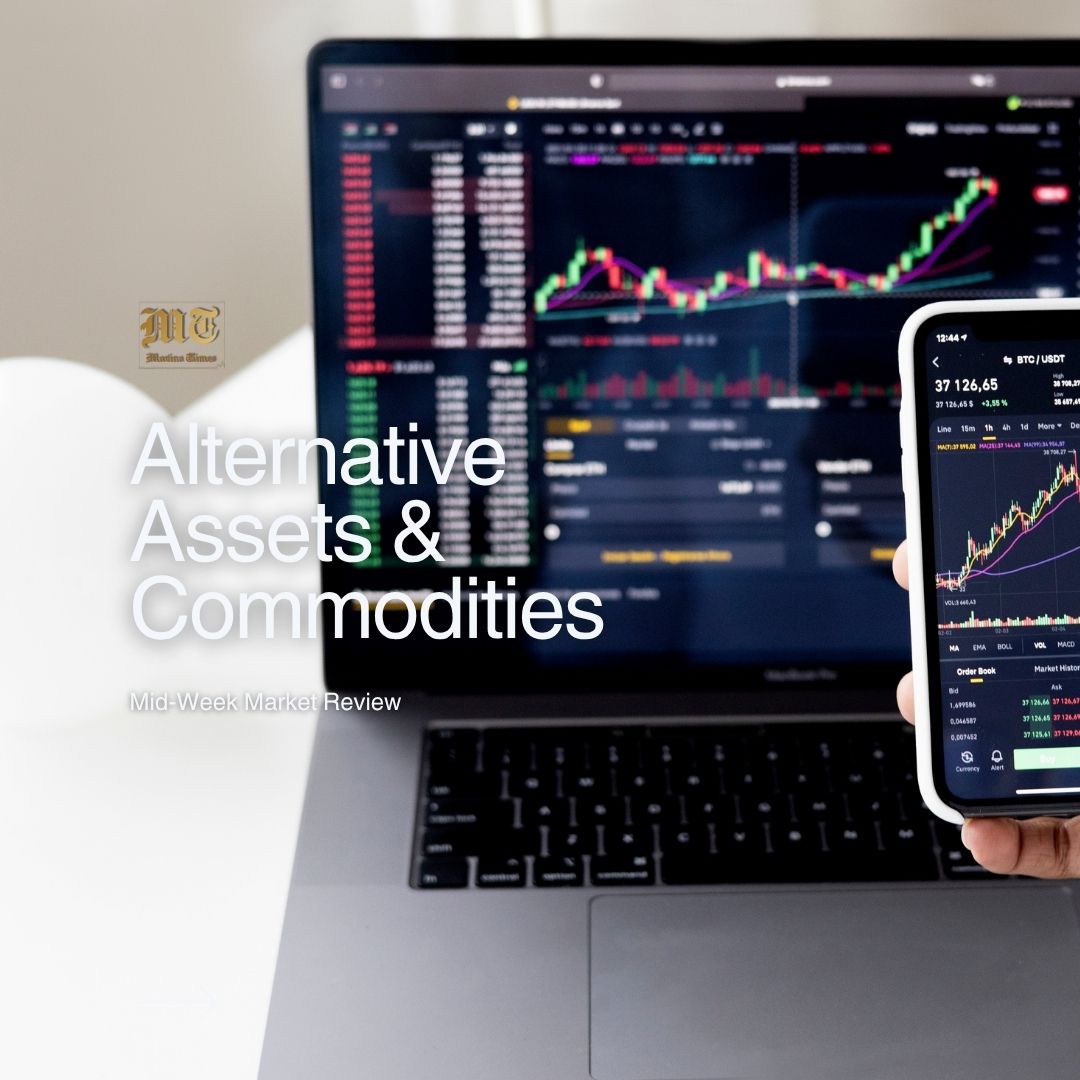

At the beginning of the week, Brent crude moved towards $65 per barrel on Monday, while WTI hovered around $61. This movement occurred after President Donald Trump announced a delay in imposing heavy tariffs on European imports. Market participants also considered the possibility of further output increases by OPEC+ at its upcoming meeting. Despite the initial rise, Brent fell by 0.31% to $64.81 a barrel, and WTI dipped by 0.73% to $61.31 by the close of the day.
President Trump announced on Sunday that the proposed 50 per cent tariffs on European Union imports would be delayed from June 1 to July 9, allowing more time for negotiations. The move calmed fears of an escalating trade conflict, which could have otherwise weakened global economic growth and energy demand.
Oil prices also found support from geopolitical developments in the Middle East. On Sunday, Israel’s military stated its plans to control 75% of the Gaza Strip within two months, fuelling concerns about a broader regional conflict. Simultaneously, reports of limited progress in US-Iran nuclear talks eased fears of an imminent surge in Iranian oil exports.
Eight OPEC+ members who had previously committed to additional voluntary cuts are set to meet on May 31st, a day earlier than originally planned, to finalise output levels for July, likely confirming a 411,000 bpd increase. This follows earlier agreement in May to accelerate output growth for a second consecutive month in June.
Both Brent and WTI traded higher earlier in Monday’s session after President Trump’s announcement regarding the tariff delay. Brent crude climbed to around $64.70 per barrel on Tuesday, while WTI steadied near $61, as easing trade tensions helped offset market concerns about additional supply from OPEC+.
Days | Brent | WTI |
Friday – 23/5/2025 | $65.01 | $61.76 |
Monday – 26/05/2025 | $64.81 | $61.31 |
Tuesday – 27/05/2025 | $64.70 | $61.00 |
Meanwhile, Iran signalled it would not suspend uranium enrichment, despite recent optimism from President Trump about a potential agreement. President Pezeshkian reiterated that Iran could manage without a deal, implying that sanctions would likely persist, keeping Iranian oil largely out of global markets and supporting prices.
On Wednesday, Brent crude oil futures fluctuated around $64 per barrel while WTI crude oil futures fluctuated around $61 per barrel as traders awaited an OPEC+ meeting expected to decide on increasing oil output. OPEC+ will likely approve a 411,000 barrels per day production hike for July, continuing a trend of accelerating supply growth following a similar increase planned for June.
However, Russian Deputy Prime Minister Alexander Novak noted that the group had not officially discussed the output increase. President Trump also expressed frustration with Russian President Putin amid stalled peace negotiations in Ukraine, suggesting that fresh sanctions against Moscow might be unveiled as soon as this week. Additionally, the US barred Chevron from exporting Venezuelan crude under a new authorisation that allows the company to maintain assets, but not to export oil or expand its activities. European Union officials are equally gathering information on US investments from major companies after Trump stepped back from plans to impose hefty tariffs on European goods.
A retrospective look at last week’s events showed that oil prices rose on Friday as US traders adjusted their positions ahead of the three-day Memorial Day weekend, against the backdrop of continued uncertainty surrounding nuclear negotiations between American and Iranian officials.
Brent crude futures settled at $65.01 per barrel, gaining 1.47%. Likewise, WTI crude futures ended at $61.76, an increase of 1.55%. However, despite the day’s gains, both benchmarks recorded weekly losses. Brent dipped by 0.49%, while WTI slipped by 1.17%.
Memorial Day traditionally marks the start of the US summer driving season, a period known for heightened demand for petrol and other motor fuels.
Data from Baker Hughes released on Friday showed that US energy firms cut the number of active oil and gas rigs for the fourth straight week, bringing the total to its lowest level since November 2021. The combined oil and gas rig count, a key indicator of future production, fell by 10 to 566 for the week ending 23 May.
The number of oil rigs declined by 8 to 465, also a low not seen since November 2021. Gas rigs were reduced by 2, settling at 98, their lowest since last month.
State-specific figures revealed further drops. New Mexico saw a loss of 2 rigs, leaving it with 92, the lowest since February 2022. North Dakota also dropped 2 rigs, now totalling 30, its lowest since November 2023. Texas, the largest producer, posted the steepest fall, shedding 5 rigs to reach 266; the lowest since November 2021.
The global cryptocurrency sector has experienced a week of pivotal activity, marked by geopolitical maneuvering, bold institutional plays, policy experimentation, and renewed enthusiasm for blockchain innovation across the globe, demonstrating that the digital asset revolution is not only in motion; it is accelerating.
In the United States, a flurry of financial and political activity signalled deepening entrenchment of crypto into mainstream discourse. Circle, the issuer of USDC, currently the second-largest U.S. Dollar-backed stablecoin announced its long-anticipated initial public offering (IPO) on the New York Stock Exchange. Circle seeks to raise up to $624 million at a valuation of $6.71 billion through the sale of 24 million shares priced between $24 and $26. The move is widely interpreted as a strategic pivot toward institutional legitimacy at a time when U.S. regulators continue to sharpen their focus on stablecoins. ARK Investment Management, led by Cathie Wood, signalled a strong vote of confidence by expressing intent to purchase up to $150 million in shares. The IPO marks a historic moment, as no stablecoin issuer of Circle’s scale has previously gone public.
Donald Trump’s relationship with cryptocurrency entered a new and controversial phase this week. Trump Media & Technology Group (TMTG) revealed plans to raise as much as $3 billion to invest directly in Bitcoin and other digital assets, leveraging $2 billion in new equity and $1 billion in convertible bonds. This aligns with Trump’s broader goal to position the United States as a dominant player in the digital asset space. However, the week’s political theater didn’t end there. On May 22, Trump hosted a private dinner for top holders of his $TRUMP memecoin, including billionaire Justin Sun, who disclosed he holds over $20 million of the token. The event, described by critics as a flagrant example of conflict of interest, has sparked calls for investigations into campaign finance compliance and foreign influence concerns.
State-level innovation in the U.S. also made headlines. In Texas, the House of Representatives passed Senate Bill 21, laying the groundwork for the creation of a strategic Bitcoin reserve. If the governor signs the bill into law, Texas will become the first U.S. State to hold Bitcoin in cold storage for up to five years as a hedge against inflation and monetary instability. This move would reinforce Texas’s growing identity as a pro-crypto jurisdiction, already supported by a significant presence of Bitcoin miners.
Beyond the United States, global developments suggest the digital asset economy is no longer the exclusive domain of tech startups or Western financial hubs. In a major announcement, the Central Bank of the United Arab Emirates confirmed that its central bank digital currency (CBDC), the Digital Dirham, will launch in Q4 2025. The Digital Dirham is expected to be accepted across all payment platforms, acting as a fully fungible digital equivalent of physical cash. The project aims to enhance financial inclusion, reduce remittance costs, and strengthen financial crime prevention infrastructure. Observers see this as a bold and strategic move to make the UAE a global fintech leader and a destination for blockchain-based finance.
In Central Asia, Kyrgyzstan deepened its commitment to blockchain integration. The country announced plans to create a national crypto reserve backed by Bitcoin and Binance Coin (BNB), supported directly by Binance co-founder Changpeng Zhao. In parallel, a new partnership with Binance aims to establish a public crypto payment infrastructure and introduce blockchain education across universities, signaling the country’s intent to weave digital assets into its broader economic development plan.
In Pakistan, regulatory momentum has accelerated as the government works to establish a coherent policy framework for digital assets. The country is seeking to attract international investment by positioning itself as a credible, forward-thinking hub in the Web3 space. A new partnership with World Liberty Financial an American crypto firm reportedly owned by 60% members of the Trump family has drawn both intrigue and skepticism. The deal aims to lay the groundwork for Pakistan’s own crypto-enabled financial services ecosystem, though questions linger about the transparency and strategic motives behind the agreement.
In Australia, Senator Gerard Rennick ignited backlash after dismissing Bitcoin as a Ponzi scheme just days after it reached a new high of AUD $111,977. Industry leaders, including the Australian Bitcoin Industry Body, condemned the statement, citing the importance of regulatory literacy and constructive engagement with emerging technologies. The senator’s comments have paradoxically spotlighted a real divide in public opinion that surrounds Bitcoin’s legitimacy in global finance.
Below is a table outlining the daily closing prices of Bitcoin (BTC) and Ethereum (ETH) from May 21 to May 27, 2025, this table reflects the significant upward trend in both Bitcoin and Ethereum prices over the past week, highlighting a bullish market sentiment in the cryptocurrency sector.
Date | Bitcoin (BTC) Closing Price | Ethereum (ETH) Closing Price |
May 21 | $93,994.77 | $2,339.96 |
May 22 | $93,946.51 | $2,180.22 |
May 23 | $94,115.02 | $1,798.25 |
May 24 | $93,917.82 | $1,777.80 |
May 25 | $94,725.76 | $1,835.78 |
May 26 | $94,136.26 | $1,838.24 |
May 27 | $94,135.12 | $1,847.07 |
Not forgetting our star boy, Michael Saylor, and his company, Strategy (formerly MicroStrategy), made another significant Bitcoin purchase this past week. Between May 19 and May 25, 2025, Strategy acquired an additional 4,020 bitcoins for $427.1 million, bringing its total holdings to 580,250 bitcoins. These holdings, acquired at a cumulative cost of approximately $40.61 billion, are now valued at around $64 billion, representing approximately 2.7% of Bitcoin’s capped supply of 21 million. Will Michael ever stop? We highly doubt it!
From legislative ambitions in Texas to digital currency implementation in the UAE, the week’s developments reflect the accelerating global embrace of cryptocurrencies not just as speculative assets but as a tool of fiscal policy, innovation strategy, and political expression. The convergence of private ambition, public experimentation, and international alignment is quickly reshaping how the world defines and deploys financial power. As digital assets become deeply embedded in everything from central bank operations to campaign trail theatrics, the stakes for investors, governments, and citizens alike grows higher.
Quotes
What Does It Really Mean?
Rumour has it that oil prices are on the rise — and one reason being floated is the US Memorial Day holiday, which saw heavy fuel demand as families travelled to gather.
Then there’s the uncertainty surrounding negotiations with Iran, and the postponed EU trade talks — all stirring the pot.
But is this good news for us?
Will the increase in oil prices actually boost our economy?
Will it reflect in the garri, bread, and eggs we buy every day?
Is this something to be over the moon about... or something to take with a pinch of salt?
Is it just another hopeful article we read in the newspapers, hear on the radio, or scroll past on social media?
By: Sandra A. Aghaizu